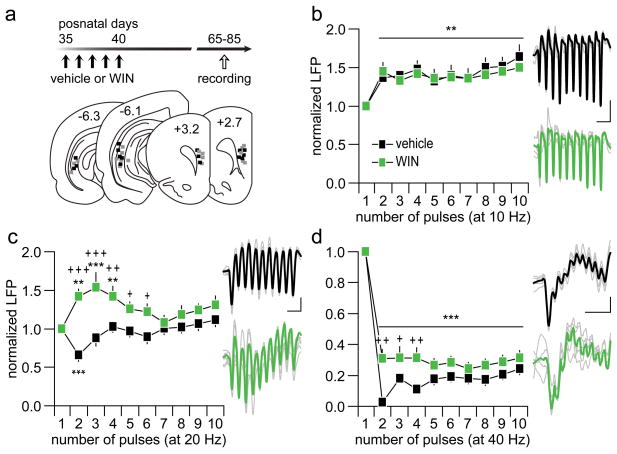Figure 1.
(a) Experimental design used to assess the impact of early adolescent (P35-40) exposure to repeated injections of the CB1 agonist WIN (2 mg/Kg, i.p.) or vehicle on prefrontal LFP responses in adulthood. (b) Adult rats (P65-85) that received vehicle (n=8) or WIN (n=9) treatment during P35-40 exhibited similar degrees of prefrontal LFP facilitation in response to hippocampal train stimulation at 10 Hz (main effect of pulse number, F(9,150)=3.3, **p<0.005, two-way ANOVA). (c) At 20 Hz, vehicle-treated rats responded with a transient LFP inhibition whereas a marked LFP facilitation was observed in the WIN-treated group (**p<0.005, ***p<0.0005 vs. first pulse, +p<0.05, ++p<0.005, +++p<0.0005 vs. vehicle, LSD post hoc test; main effect of treatment: F(1,150)=46.9, p<0.0005; treatment × pulse number interaction: F(9,150)=3.1, p<0.002, two-way ANOVA). (d) At 40 Hz, both vehicle and WIN-treated rats exhibited marked LFP depression in the PFC (main effect of pulse number: F(9,150)=74.3, ***p<0.0005, two-way ANOVA). However, a significant attenuation of the LFP inhibition was observed in the WIN-treated group (+p<0.05, ++p<0.005 vs. vehicle, LSD post-hoc test; main effect of treatment: F(1,150)=37.3, p<0.0005; treatment × pulse number interaction: F(9,150)=2, p<0.05, two-way ANOVA). Insets are example traces (vehicle: black; WIN: gray/green) of LFP recordings from the PFC during ventral hippocampal stimulation illustrating the effects shown in b, c and d (calibration bars: 3 μV/200 ms for b, 2 μV/100 ms for c and d).

